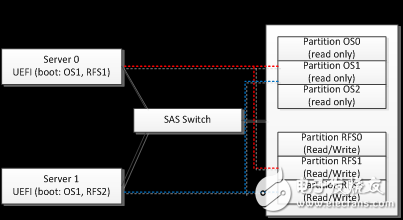Optimizing storage and boot management in a cluster environment is essential for improving efficiency and reducing costs. One effective solution is the shared boot disk service, which leverages the SAS Switch-based hardware architecture to streamline the process. Each server in the cluster typically requires a volume containing the operating system, along with virtual swap space and a root file system. The OS image is usually read-only, while the root file system is writable but less likely to be shared across machines. Managing these volumes individually for hundreds of servers can become cumbersome and expensive. A shared boot disk offers a cost-effective and scalable alternative.
Using a SAS Switch, we can implement shared boot volumes at the physical disk level. By utilizing one or two high-performance disks (such as SAS SSDs), multiple partitions can be created. These partitions serve different purposes: one stores a static, read-only OS image that can be shared across multiple servers, while others store individual root file systems for each machine. The shared boot disk is connected to the SAS Switch topology, allowing it to be accessed by all servers that need to boot from it. On the server side, a UEFI BIOS application is used to configure and manage the boot process, selecting the appropriate OS partition and root file system for each node.

In this setup, two servers—Server 0 and Server 1—share a single boot disk through the SAS Switch. Server 0 uses the OS on Partition 1 and its own root file system on RFS1, while Server 1 uses the same OS partition but has its own RFS2. This ensures that both servers operate independently without interfering with each other. However, relying on a single shared boot disk introduces a potential point of failure. To enhance reliability, it's advisable to deploy multiple shared boot disks, ideally in different fault domains such as separate JBODs or racks. This redundancy ensures that if one disk fails, the cluster can still boot successfully.
Beyond reliability, shared boot disks offer operational advantages. Upgrading the OS or applications becomes much simpler, as changes are made to the shared OS image rather than being applied to every server individually. If a server fails, it can be replaced without needing to reinstall the OS or software, significantly reducing downtime and maintenance costs. These benefits make shared boot disk services particularly valuable in large-scale data centers where efficiency and scalability are critical.
Flexible Migration and Protection of Dynamic ServicesThe SAS Switch enables flexible migration and protection of dynamic services by allowing all storage nodes in a domain to access shared storage resources. This capability is especially useful in environments like Hadoop clusters, where workload distribution and resource optimization are key. For example, in a Hadoop cluster with 10 servers and 20 data disks, performance monitoring may reveal underutilized CPU resources. By reconfiguring the cluster to reduce the number of compute nodes and redistribute data disks, the system can improve overall efficiency.
Such reconfiguration can be done dynamically, without interrupting ongoing operations. Freed-up resources, like idle CPUs, can be reallocated to other tasks or put into low-power states. This flexibility not only maximizes resource utilization but also enhances system responsiveness. In cases requiring high availability, the SAS Switch can support protection mechanisms like 1:1 or N:1 failover. When a server fails, its workload is automatically transferred to an available node, ensuring continuous service delivery and minimizing disruptions.
Hyper-Converged StorageHyper-converged storage has gained significant attention in recent years, with solutions like Nutanix and VMware vSAN leading the market. This approach integrates storage and compute functions within standard servers, eliminating the need for dedicated storage hardware and networks. It pools direct-attached storage (DAS) resources and allows both storage services and user applications to run on the same server node, offering a more efficient and scalable infrastructure.
Despite its appeal, hyper-converged storage still relies on underlying technologies like SAS Switches to enable efficient resource management. Manufacturers have recognized that using SAS Switches and JBODs alongside high-density servers provides a cost-effective way to decouple storage from compute resources. This architecture allows organizations to optimize costs by moving disks to cheaper JBODs, improve scalability by separating compute and storage, and ensure data isolation for multi-tenant environments.
As a result, SAS Switch technology has played a crucial role in enabling hyper-converged storage solutions. Its ability to provide flexible, reliable, and scalable storage access has helped drive innovation in data centers worldwide. From China’s Tianzhu 2.0 rack to global data centers, the adoption of SAS Switch-based storage pooling has marked a shift toward more advanced, efficient, and environmentally friendly cloud infrastructures. With continued support from major server vendors, the future of SAS Switch technology looks promising, paving the way for even more innovative storage solutions.
Our company offers rubber, and specialty seal and o-ring for molding electronic and electrical Connectors, both circular and rectangular types. We have in house capabilities and quick turn around.
Cable Grommets with various Grommet Shapes, Rib Styles, Slot Shapes, Inner Flanges, and Colors - To have access to our 3D Cable Grommet Design Tool
Silicone Rubber Products,Cable Silicone O-Ring,Rubber Seal,Custom Silicone Seal,Waterproofing O-Ring,Tpe Grommet
ETOP WIREHARNESS LIMITED , https://www.etopwireharness.com